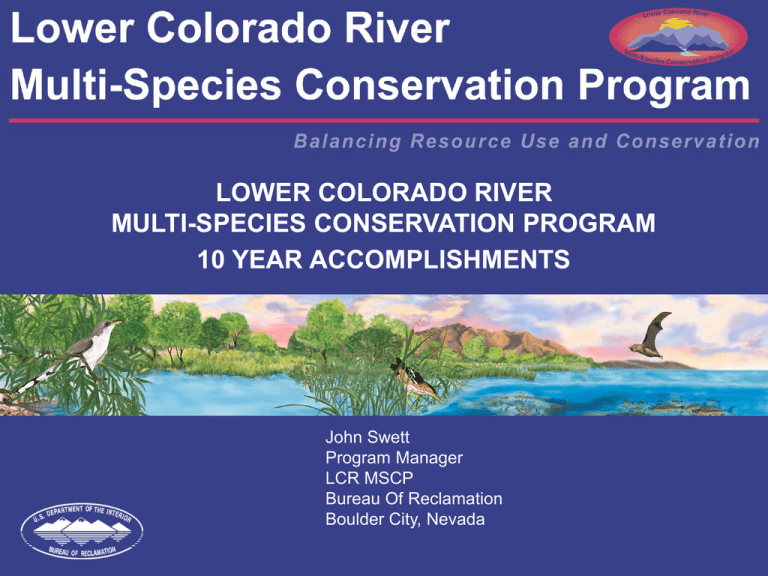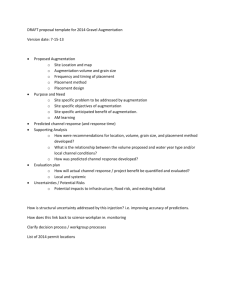PPT Presentation
advertisement

LOWER COLORADO RIVER MULTI-SPECIES CONSERVATION PROGRAM 10 YEAR ACCOMPLISHMENTS John Swett Program Manager LCR MSCP Bureau Of Reclamation Boulder City, Nevada PROGRAMMATIC ACCOMPLISHMENTS • • • • • • • • • Final Science Strategy Five- Year Research & Monitoring Priorities (2013-17) Site Selection Criteria Native Fish Augmentation Plan Habitat Maintenance Fund Process Habitat Creation Accomplishment Process Land and Water Fund Remedial Measures Fund Annual Accomplishment / Work Plans CONSERVATION MEASURES COMPLETED • DETO1: Acquire and protect 230 acres of existing unprotected occupied desert tortoise habitat • FTHL1: Acquire and protect 230 acres of existing unprotected occupied flat-tailed horned lizard habitat • AMM2: Avoid impacts of flow-related covered activities on covered species habitats at Topock Marsh NATIVE FISH AUGMENTATION GUIDELINES • Razorback sucker and bonytail augmentation program based on effort (“level of funding”) needed to raise and stock 1.2 million subadults • Stocking numbers are reach and species specific • Increased stocking over a ten-year period for research counts towards augmentation goals • Fish stocked in created backwater habitats count towards augmentation goals • Razorback suckers stocked in Lake Mohave do not count towards augmentation goals FISH AUGMENTATION GOALS • 660,000 Razorback Suckers • 620,000 Bonytail FISH AUGMENTATION ACCOMPLISHMENT THROUGH FY15* SPECIES RAZORBACK SUCKER BONYTAIL TOTAL LAKE MOHAVE 114,626** 0 114,626** DAVIS-PARKER BELOW PARKER TOTAL AUGMENTATION TOTAL 72,865 79,736 267,227 152,601 55,403 20,733 76,136 76,136 128,268 100,469 343,363 228,737 *Approximate **Don’t count towards augmentation goals – separate conservation measure CONSERVATION AREA DEVELOPMENT AND MANAGEMENT GUIDELINES • LCR MSCP is habitat based • HCP conservation measures are species specific • Total habitat creation acre goals are based on creating habitat mosaics (i.e. each acre should provide habitat for multiple species) • Total habitat creation acre goals are a minimum which allows flexibility in meeting species specific conservation measures CONSERVATION AREA DEVELOPMENT AND MANAGEMENT : TOTAL MINIMUM ACRES • Cottonwood-Willow - 5,940 Ac • Mesquite - 1,320 Ac • Marsh – 512 Ac • Backwaters – 360 Ac LAND COVER TYPE BY STATE THROUGH FY15* STATE ARIZONA CALIFORNIA NEVADA TOTAL *APPROXIMATE COTTONWOODWILLOW HONEY MESQUITE MARSH BACKWATERS TOTAL 1,465 575 628 80 2,748 980 578 40 0 1,598 0 0 0 15 15 2,445 1,153 668 95 4,361 HABITAT CREATION PROGRESS LAND COVER TYPE ESTABLISHED THROUGH FY15 ANTICIPATED SCHEDULE FROM HCP (PERCENT COMPLETED) PERCENT OF MINIMUM TOTAL ACRES COTTONWOODWILLOW 2,445 1,000 (244%) 5,940 (41%) HONEY MESQUITE 1,153 300 (384%) 1,320 (87%) 668 150 (445%) 512 (130%) 120 (79%) 360 (26%) MARSH BACKWATERS TOTAL 95 4,361 1,570 (284%) 8,132 (54%) CESA HABITAT CREATION PROGRESS LAND COVER TYPE ESTABLISHED THROUGH FY15 PERCENT OF MINIMUM TOTAL ACRES REQUIRED IN CALIFORNIA COTTONWOOD-WILLOW 980 1,566 (62%) HONEY MESQUITE 578 1,048 (55%) 40 240 (17%) MARSH BACKWATERS TOTAL 0 1,598 194 (0%) 3,048 (52%) ACCOMPLISHMENTS • “Build it and they will come” - Most riparian and marsh species are responding to the created habitat • Razorback suckers are being observed in greater numbers in some reaches, especially Reach 3 • The Flexibility in the program documents and the adaptive management approach have allowed us to meet challenges CHALLENGES • Securing land & water in California to meet CESA requirements • Increasing native fish survivorship within the constraints of the program • Developing long-term management guidelines for created habitats • The “Unknown” (i.e. Drought, Climate Change, Invasive Species, etc.)




